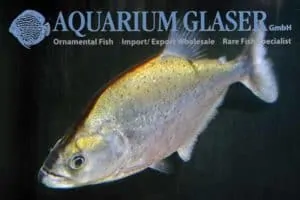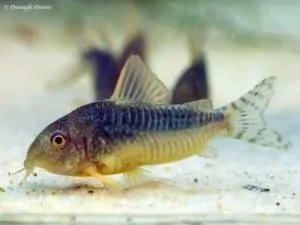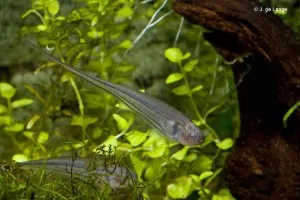Otocinclus macrospilus – Tailspotted Oto
Otocinclus macrospilus was officially described by Eigenmann and Allen in 1942. The name Otocinclus can be broken down into two words. Ous, oto comes from ancient Greek and means ear. Cinclus comes from Latin and means latticework, a reference to the holes in the head for the ears.
Description
Otocinclus macrospilus can reach a maximum total length of about 3.5 centimeters. The ground color is light beige. A dark brown stripe runs along the lateral line and is interrupted at the base of the caudal fin. A clear dark spot is visible on the caudal peduncle. We see the same brown color on the top of the fish, which is brown marbled. The belly side is more of a light beige/white color.
This species looks very similar to Otocinclus vittatus, and is often offered under that name. The most obvious difference is the black band that runs across the flank: in this species it is interrupted before the base of the tail, in Otocinclus vittatus it runs uninterrupted. In addition, the coloring on the back of this species is more marbled (see photo).
Character
An active, peaceful and generally harmless companion fish for other fish (exceptions are Angelfish and Discusfish, to which Otocinclus sometimes like to attach themselves) that should always be kept in a group, at least 5-6 specimens, but preferably 10 or more . House these fish in a densely planted aquarium that offers sufficient shelter through large-leaved plants (such as Sword Plants), rounded pebbles (to provide the necessary surfaces for algae to grow on), driftwood and a layer of rounded gravel as a substrate to prevent injuries. to prevent the mouth from breaking while foraging on the bottom.
Origin
South America: upper Amazon, Colombia, Ecuador and Peru.
Diet
This small catfish is often kept to combat algae problems: algae form an integral part of the diet. But these fish often go through the algae supply faster than new algae are formed, and for that reason additional feeding is necessary: think, for example, of plant-based food such as algae/spirulina tablets and vegetables (cucumber, eggplant, zucchini, lettuce leaves and blanched spinach), but also meat-containing foods such as sinking carnivore tablets, tubifex and mosquito larvae are often accepted without any problems.
The Aquarium
An aquarium of 45 centimeters in length is sufficient for a small group of about 5 specimens of these social and very active algae eaters. A densely vegetated aquarium with plenty of hiding places in the form of driftwood and rocks and dim lighting is preferred.
The Tailspotted Oto can be kept with other species without any problems, provided sufficient hiding places are provided. Naturally, a somewhat larger aquarium is necessary: for a group of about 8 to 10 fish, an aquarium with a length of 80 centimeters is a good home.
Optimal is soft, slightly acidic water, which can be obtained by filtering over peat or using Black Water Extract. But the Otocinclus is a particularly strong, adaptable fish, and will also do well in harder, more alkaline water.
Breeding Otocinclus macrospilus – Tailspotted Oto
The Otocinclus macrospilus has been bred in captivity, but breeding is difficult and uncommon. The laying of the eggs is actually the same as with Corydoras species. Just like the Corydoras, they assume the T-position where the male grabs the female with his pectoral fins and body. The eggs are released by the female and fertilized by the male.
The eggs are often released between the fine-leaved plants, but also along the glass of the aquarium, after which they fall down.
Getting the fish to actually spawn is difficult. Possible options to try are:
- Change the water with slightly colder water.
- Add other species that also breed (probably the Otocinclus is then triggered by released hormones).
After a few days the fertilized eggs hatch. The young are really very small. They then feed on small algae present in the aquarium. If you use a separate breeding aquarium, make sure it is properly set up so that they can find their own food. You can also feed them with a very small amount of finely crushed spirulina flakes.
Comments
Like most Otocinclus species, the first 2-3 weeks are critical: losses are particularly high during this initial period. Important are good (read: slow) acclimatization, a stress-free environment and a good and nutritious diet (almost all specimens are wild-caught, and a large proportion of the fish arrive starving). It is therefore advisable to keep a close eye on the new fish during the first weeks.
Video
Author
Jonas Hansel – Piranha-info.com
Copyright images
Jonas Hansel – Piranha-info.com








Reviews
There are no reviews yet.